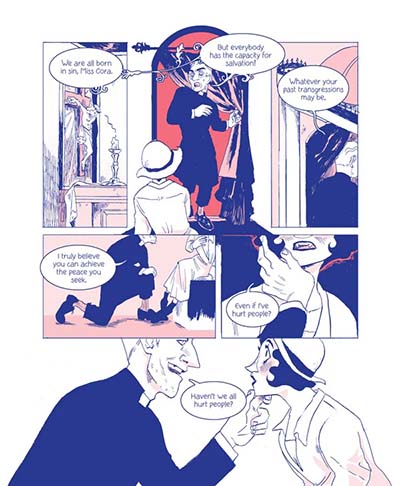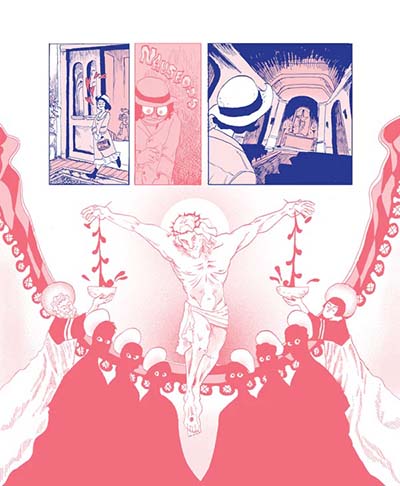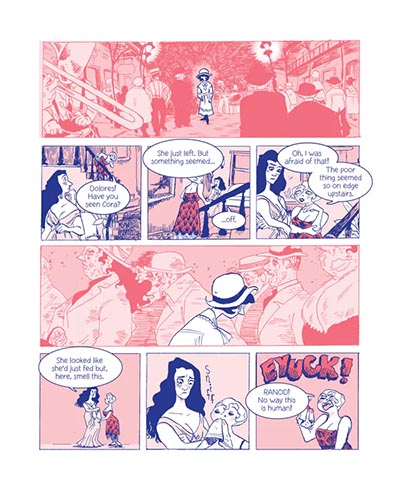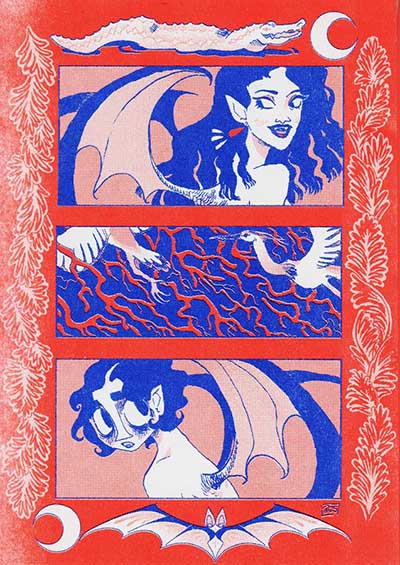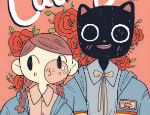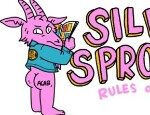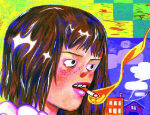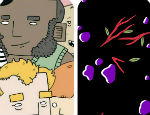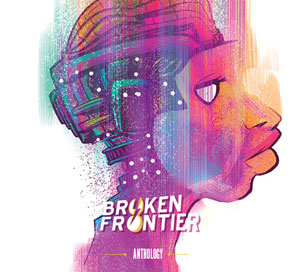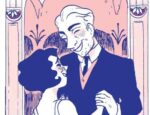Here at Broken Frontier, we recently had the pleasure of reviewing Paige Hender’s debut graphic novel The Confessional from Silver Sprocket. ‘Sensual, grisly and totally unique’, this compelling horror focuses on a newly-turned vampire, seeking salvation in all the wrong places. We got to catch up with author and artist Paige Hender, to chat all things vampires, priests and blood!
BROKEN FRONTIER: Tell us a bit about yourself. Have you always wanted to get into graphic novels? What graphic novels or creators have inspired you?
PAIGE HENDER: Hi, I’m Paige Hender! I’m an Aries, I have dual citizenship, and I just had a lavender latte. I always wanted to get into the arts, but I waffled on what I wanted to do for a long while. I wanted to be an illustrator, an animator, a tattoo artist, a concept artist, you name it. I think I settled on comics around the time I started college. I had a lot of online friends who were making webcomics, and I dipped my toes into it as well. One of my favorite artists at the time was Maya Kern, and she was running a webcomic called Monster Pop! that I adored. That was how I first found out about the Minneapolis College of Art and Design, which Maya graduated from. So after a year and a semester at Louisiana Tech in a studio art program that made me absolutely miserable, I took a year to figure out what I really wanted to do. I applied to the MCAD comic art program kind of on a whim, and wound up getting a really good scholarship! And the rest is history.
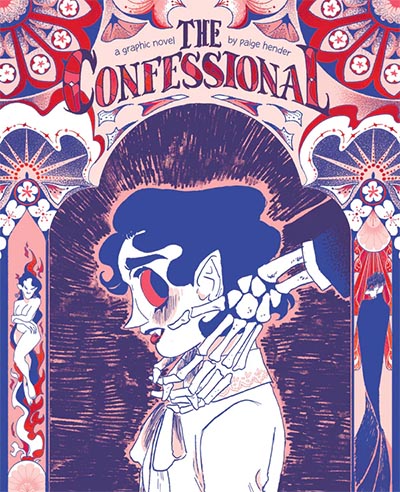
I already mentioned Maya Kern, and some of my other favorites are Kerascoët, Tove Jansson, E.M. Carroll, GGDG, Joann Sfar, Junji Ito, and Rumiko Takahashi. I’m also a big fan of Angela Carter and Susanna Clarke’s prose. I think I wear my influences pretty openly on my sleeve, since a couple of those names have been called out in reviews of The Confessional already.
BF: Can you tell us about the premise of The Confessional, and how it felt to craft your first graphic novel?
HENDER: The Confessional follows Cora Velasquez, guilt and shame personified. She’s only been a vampire for a year, and still struggles to feed. She feels so much shame over her nature that she restrains herself from dining on human blood for as long as possible, but when she finally snaps and goes on the hunt, she can’t control her bloodlust. This is a problem for her sister and the coven she lives with, who are trying to keep a low profile. It is NOT a problem, however, for the priest she’s been aching for. In fact, he sees a way to use her curse as a path to redemption.
The Confessional began life as the most self-indulgent story I could think of. All I had at the beginning was “vampire brothel, priest, period setting, sexy”. And over time, working with both my classmates and teachers at MCAD, the story evolved into a tale of corruption and redemption. From there, my incredible editor Ari Yarwood and the team at Silver Sprocket helped craft The Confessional into what you see today! It was a really surreal feeling holding the book in my hands for the first time. I drew the whole thing traditionally, so I have this HUGE stack of 11×14” bristol that constitutes the whole book. And it all became this beautiful, compact little book that sparkles in the sunlight and catches your eyes from a distance. I really couldn’t be happier with the end result.
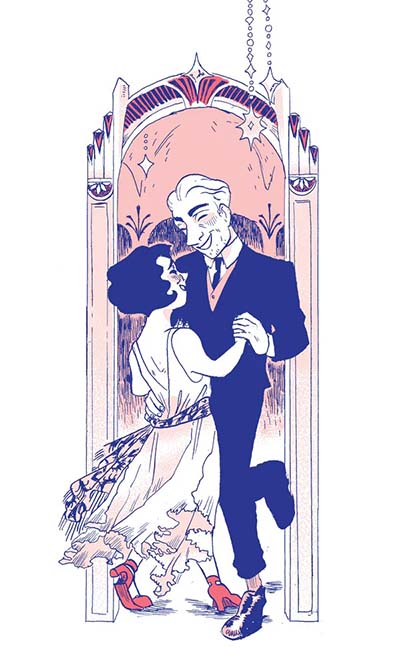
BF: I loved that the setting was a New Orleans speak easy, with all the glitz and glam – was there anything about the prohibition era that made you want to set your story in that time period?
HENDER: As a visual artist, the aesthetics of the jazz age are like a siren song. I love drawing vintage fashions and settings, and to me any setting in the early 20th century or before has the potential for an eerie fairy tale feeling. The 1920s in America is also defined by this sort of looming doom: the rise of counterculture and liberal living will eventually give way to a fascist backlash. The Great War is over, but there’s an even worse one around the corner. We’re spending money as fast as we can make it, but we won’t be able to make it for long. There’s also this wonderful contrast between the deprivation of prohibition and the indulgence of the culture at large.
I specifically used the early 1920s because I didn’t want to lean too far into the stereotypical image of the era. Flappers really only became a fixture of the culture in the latter half of the decade, with Josephine Baker and the Charleston gaining ubiquity around 1925-26. As much as I love a fancy flapper dress, I’m more interested in what non-partiers were up to at the time. Maybe it’s because I’m currently living in a time of political upheaval and I’m not a club girl, I want to know what the women like me were doing and wearing one hundred years ago. Let’s be real, we all like to think we would be a flapper but I don’t think I’d be brave enough to wear a skirt higher than my mid-calf.
BF: Vampires are such a hot commodity in literature – whether it’s a classic like Dracula, or a YA romance like Twilight – and the morality of their bloodthirsty habit is often a subject of much discussion. Why did you feel Cora’s story was particularly important to tell?
HENDER: I had a teacher once who took one look at The Confessional and said he didn’t like it because he didn’t like reluctant vampire stories. And I get where he’s coming from. But I, for one, think that all vampires are good vampires. Cora is a character that I think a reader will recognize very quickly. She’s a young adult, only being 22 when she was given the dark gift, and she carries a lot of shame and insecurity. I think we all have something deeply intrinsic to us that we’ve been ashamed of at some point or another. Probably not drinking blood, but still! Cora has to learn to accept herself and her nature or else she’s not going to be able to survive. In a way, her feeding on human blood is an act of self-affirmation. She deserves to be alive, her sister was right to turn her into a vampire, and there is a place for her on this bitch of an Earth.
BF: There’s a lot of Biblical imagery throughout the book, particularly its focus on cathedrals. Were you inspired by any particular religious imagery or monuments?
HENDER: Cathedrals were a big inspiration, not just for Orville’s church but for various design details throughout the story. If I wanted to get pretentious with it, you could say that Orville’s design itself takes some inspiration from gothic architecture. He is a distinctly vertical character, made of long, lean, uninterrupted lines. Even when he’s out of his cassock, I tend to draw him in a long trench coat that obscures his silhouette and emphasizes his height. I also took inspiration from Renaissance-era depictions of Hell – shout out Bosch – for some particular scenes. Catholic imagery of saints and martyrs is already so dark and gothic, it fits in perfectly with a story like this.
BF: Not to give away spoilers for those who haven’t read yet, but Father Orville is a heck of an antagonist throughout, but, like a lot of relationships with a power imbalance, he somehow manages to keep Cora under his thumb. Did you feel you wanted to send a message to readers about the toxicity of a co-dependent relationship such as this one?
HENDER: Oh absolutely. It was always my intention to depict Orville as the worst sort of boyfriend possible. I’m someone who can very easily become dependent on other people in unhealthy ways, and so Orville is basically my perfect trap of a man. He gives just enough affirmation and affection to keep Cora around, and by the time she realizes something is wrong, he’s already got himself so entangled in her life that it would be difficult to separate from him. He also purposefully takes her away from her support network, isolating her as much as possible. So even when she knows it’s time to get out, she doesn’t know whether or not there will be anybody waiting for her on the other side. I’m by no means the person to go to for advice on getting out of a co-dependant relationship, but maybe someone will recognize a few of Orville’s actions in their own lives and start to question their situation.
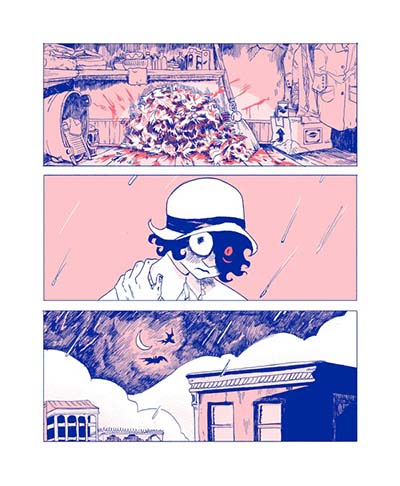
BF: The art style is so unique, with your love of Art Nouveau particularly shining through. Could you talk to us a bit about the artistic themes throughout?
HENDER: Thank you! I took a lot of inspiration from European cartoonists like Kerascoët and Tove Jansson, since their work feels so timeless and sophisticated. There’s also some Aubrey Beardsley inspiration thrown in there, with large swathes of solid black being interrupted by moments of intricate detail. There are a few overt references to extant art – like a very on-the-nose reference to A Streetcar Named Desire and a direct reference to Pénot’s La Femme Chauve-Souris.
I use a lot of nature imagery in this book, particularly thorns and water. Thorns are used symbolically throughout to reference Cora’s anxiety and fear, but are also represented in the thorny crown of Christ always watching over Orville’s church. Cora and Orville hide evidence of their deeds in a swamp, trusting the water to conceal their sins. And in a pivotal moment, Cora is symbolically baptized in a bathtub. Color also plays an important role in the narrative, especially since I used such a limited palette. This is only a two color book, with blue and red ink being used and the red showing up in various opacities. The fully saturated red is only used in moments of heightened emotion or action, to emphasize the scene. Cora also only wears white or light colors, only wearing darker clothing at the very end to symbolize a change in her life.
BF: Do you have any future projects coming up, and how can our readers keep up to date with all the cool stuff you’re doing?
PH: My next book is a young adult fantasy comic from Holt Young Readers called Witch’s Inheritance. It’s about a girl named Edie who reunites with her estranged family only to discover that there’s an entire side to her life that she knew nothing about: namely witchcraft. It’s a story about confronting a family history too late to do anything about it, and still trying your best to overcome it. We don’t have a solid release date yet, but expect Witch’s Inheritance on shelves next year! I have another YA book in the works, more info to come from that soon!
I can be found on Instagram @paigudoodle and on Bluesky @paigumondus. I don’t post as often as I should, but I do chat about my knitting and have opinions on the best Fire Emblem romances. Thank you so much for your time and spreading the word about The Confessional!
Buy The Confessional online here
Interview by Lydia Turner





